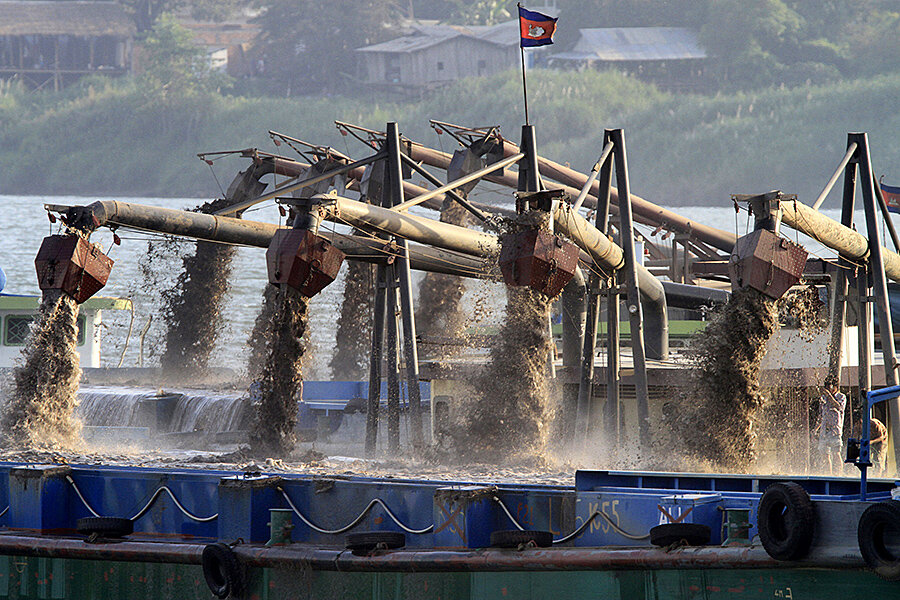Cambodia's villagers lose ground – literally – to Singapore's expansion
Loading...
| Koh Sralav, Cambodia
Singapore is a long way from this remote Cambodian fishing village – nearly a thousand miles across the sea. But as the bustling city-state grows, Koh Sralav and hamlets like it die. All because of sand.
Singapore is expanding; its land reclamation projects make it the largest sand importer in the world. Politically connected Cambodian firms have rushed to meet the demand. Local fishermen, and one of Southeast Asia’s largest mangrove forests, are paying the price.
Sand dredgers have deepened the shallow estuaries around this village by several meters. That has created strong currents which have eaten away at the riverbanks, destroying long stretches of mangrove.
The crabs and fish that once lived among the mangrove roots, the mainstay of most family economies around here, are disappearing.
Villagers say their protests eventually pushed the dredgers out. But that victory came too late for Thy Rya, a young woman whose husband has left Koh Sralav. “My husband could not find crabs anymore, so he went to work as a construction worker in Koh Kong city,” she says.
Before the dredgers arrived, she recalls, her fisherman father could make the equivalent of $12 a day. By the time her husband left, their family income had decreased to a small fraction of that.
Today, the only signs of the business that ruined Ms. Rya’s livelihood are abandoned piles of sand on the riverbanks and rusting barges, sinking into the muddy water.
A murky business
The dredgers are more active further east, in Andong Toek, where barges and excavators churn up the river right in front of local peoples’ houses. The water is slick with oil stains and hardly a fishing boat is to be seen; catches are down 90 percent, says resident Thith Kun. “All the fish and crabs are gone,” he laments. “It is really difficult to live. I have four children and I do not know how to feed them.”
Like many in Koh Kong, a coastal province in Southwestern Cambodia, Mr. Kun has fallen prey to an industry whose operations are shrouded in secrecy. It is not clear, for instance, why miners have been allowed to dig for sand in mangrove forests that are protected under the Ramsar Convention, an international treaty to preserve wetlands across the globe.
Nor does it appear that the mining companies followed legal requirements to carry out environmental impact assessments (EIAs) before dredgers got the green light.
Local opinion, meant to be an important element in any feasibility study, was certainly not taken into account.
“Before the dredgers arrived, some people came,” says Sos Nara, a middle-aged fisherman who lives in Koh Sralav “We said we did not want any dredging, but they told us that whether we agreed to it or not, they would come anyway.”
This is hardly unusual in Cambodia, local observers say. “Sometimes the authorities say they have EIAs, but in reality they never consult with people,” contends Vann Sophath, a land reform expert with the Cambodian Center for Human Rights. “In most cases, local authorities do nothing about this.”
Last February, the Ministry of Mines and Energy announced it would “soon” release studies carried out by two mining companies working in Koh Kong. But even if that happens, it might be already too late for the affected communities, which have been protesting against the dredgers for years.
Some have paid a price for doing so. Three members of Mother Nature, a Koh Kong-based environmental group, were arrested last year and given an 18-month suspended prison sentence for “threatening to cause destruction, defacement, or damage.” Alex Gonzalez-Davidson, the organization's co-founder, was deported from the country.
The sand dredging is taking place without any control whatsoever, Mr. Gonzalez-Davidson complains. “Licenses have been issued with complete disregard for relevant laws and procedures, and ignoring the widespread voices of discontent from the local fishing communities,” he says.
That suggests to some observers that highly placed Cambodians are involved in the murky sand trade. In a 2009 report, anti-corruption watchdog Global Witness found that two senators belonging to the ruling Cambodian People’s Party owned dredging companies.
“Judging by the systematic violation of the law, the volume of money being made in the sector, and the level of repression by state organs against those opposing the sand mining, people at the very top of the government and their corrupt business partners are very much engaged,” Gonzalez-Davidson believes.
Rising opposition
The sand industry attracts little international attention, but it is big business in Southeast Asia. Singapore alone imported 517 million tons of sand in the two decades up to 2012. Between 2010 and 2015 it bought 56 million tons from Cambodia, its largest supplier since Malaysia and Indonesia banned sand exports on environmental grounds.
The booming city-state has plans to add land area the equivalent of Manhattan by 2030, which could be bad news for the fishermen of Koh Kong province.
But they have not lost hope. Their protests forced the dredgers out of Koh Sralav, they say, and they intend to go on protesting. “Before Mother Nature came, the company dredged a lot, there were so many ships,” says Mr. Nara. “But after the protests, they could not go on like before.”
Gonzalez-Davidson is optimistic, too. “There are more and more effective and engaged activists on the ground, and exposure of these issues in the media is ... increasing,” he says. “I am hopeful that the new generation of government officials who are coming in will eventually be able to reverse things.”





